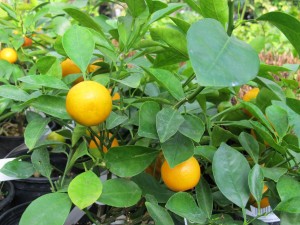Calamondin (Citrofortunella mitis) hails from China and is hardy to 20 ºF in temperate regions. It prospers outdoors in Florida, central and southern Texas, and Southern California gardens. Its sweetly fragrant flowers develop into edible ornamental fruits beginning in late fall. Small 1-2 inch diameter orange fruits are highly decorative as an indoor house plant.
Calamondin can be grown in a large tub or portable container plant in colder regions where do not commonly grow. It thrives in bright light near a window for best growth and fruiting, but will tolerate lower light levels in winter. It is the most popular potted citrus, along with Meyer lemon and Ponderosa lemon. It performs well as a summer patio plant; it may be trimmed as a hedge in warm zone 8 and further south.
Water plants as needed; excess or lack of water will kill calamondin. Repot your plant in mid- to late winter. Add a slow-release fertilizer such as Osmocote™ to the container in early spring and continue fertilizing with full strength water-soluble acidic fertilizer (Miracle Gro™ or Peters® 20-10-20 or Schultz®) monthly over the summer and early fall. Fertilize sparingly during the winter months using one-half strength water-soluble fertilizer every 4-5 weeks.
Calamondin may bloom 4-5 times a year. The spring growth flush often produces the most flowers. The flowers are self-fertile and require no cross-pollination. Flower and fruit often will appear at the same time. Calamondin fruits take nearly a year to ripen.
Fruits are thin skinned and have short keeping life of 1-2 weeks after picking. If you eat the fruit, choose firm yellow to yellow-orange fruits. Use pruners or scissors to harvest off the tree instead of pulling them. Prune calamondin in late winter before the spring growth flush. Most cuts are for shaping and size control. Remove dead or damaged twigs at any time.
Plants should be inspected for mites, mealy bugs, scales, and aphids every few weeks; particularly check the underside of leaves. Insecticidal soaps and neem oil are effective in managing pest outbreaks.


 Posted in
Posted in 
